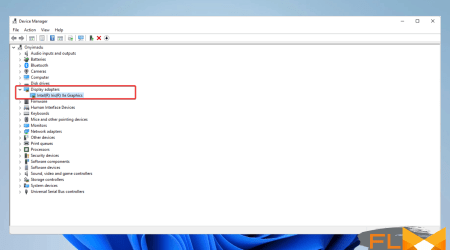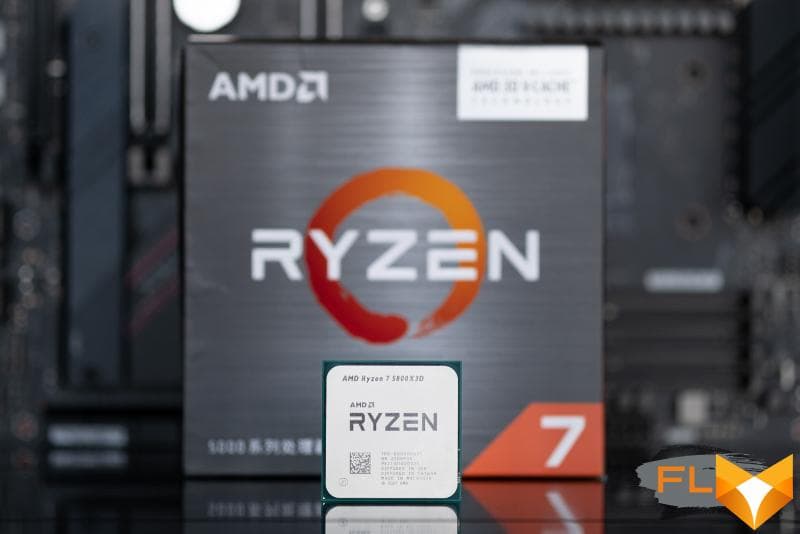


Ryzen processors with 3D V-Cache technology, which expands cache memory using an additional SRAM semiconductor die, were first mentioned by AMD exactly a year ago at Computex 2021. And then this announcement made a splash. On the one hand, AMD confirmed its technological potential through it, as it demonstrated its readiness to introduce advanced 3D semiconductor chip assembly technology and expand the chiplet design of its processors in the vertical direction. On the other hand, she promised to significantly strengthen the Ryzen 5000 series of processors by the end of 2021 by adding a flagship 12-core processor with a giant cache and seriously increased performance in gaming applications.
However, these Napoleonic plans – at least in their original form – were not destined to come true. The promised Ryzen 9 5900X with 3D V-Cache technology never came out, and instead, a few months late, AMD released another consumer CPU with increased cache memory using this technology – Ryzen 7 5800X3D. And, frankly, it looks much less impressive.
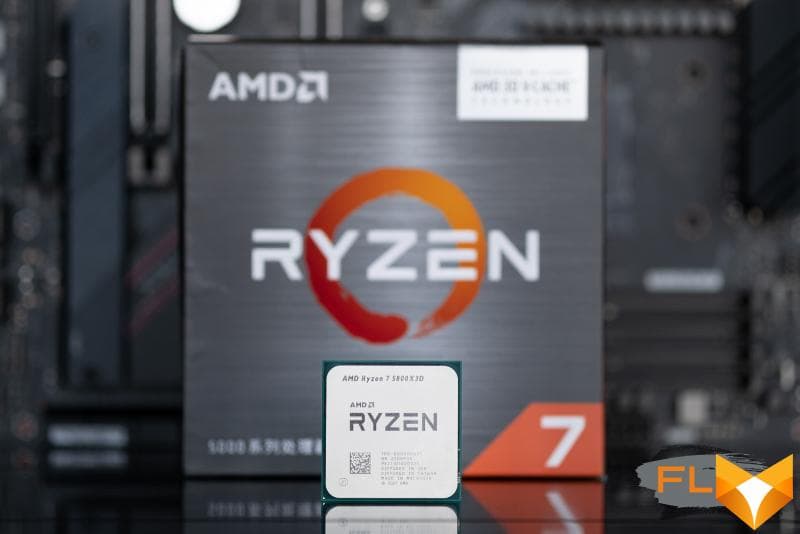
Firstly, the Ryzen 7 5800X3D is just an eight-core, which obviously cannot be a universal flagship solution, since 12- and 16-core solutions have long been widely available in the desktop segment. Secondly, by the end of this year, more advanced processors based on the Zen 4 microarchitecture will appear in the AMD arsenal, which will almost certainly outshine the Ryzen 7 5800X3D due to an increase in IPC and support for DDR5 SDRAM. And thirdly, thanks to the introduction of the Alder Lake family at the end of last year, the leadership in desktop processor performance has passed to Intel. Due to the fact that Alder Lake offers higher specific performance than Zen 3, the Ryzen 7 5800X3D is now forced to solve a completely different task: it does not set new performance records in games, but only tries to overtake the competitor’s processors in an extensive way – due to a multiple increase the amount of cache memory.
In other words, as a result, the release of the Ryzen 7 5800X3D turned out to be rather emasculated, and it seems that AMD lost a lot because it missed the deadlines and made a completely different model that it promised. However, this does not stop her from talking about the Ryzen 7 5800X3D as “the world’s fastest gaming processor.” However, there is a feeling that AMD is overestimating the capabilities of its product: at least many independent reviews could not confirm the correctness of AMD in evaluating the performance of the new product. And for this reason, we decided to test the Ryzen 7 5800X3D ourselves. Moreover, this is not just an AMD processor unique in its design, but also a kind of final feature in the history of the Socket AM4 ecosystem: its development on the Ryzen 7 5800X3D completely stops, and no other CPU models for this processor socket will be released anymore.
⇡#3D V-Cache technology in detail
The idea of increasing the capacity of cache memory for the sake of performance improvement came from AMD, obviously not from scratch. Moving large amounts of data closer to the processor cores, which dramatically increases the speed of accessing them, is a fairly simple trick that AMD liked before. AMD processors have long stood out for their cache sizes, and the company’s marketing department uses the name Game Cache for it, directly indicating that a capacious L3 cache is extremely useful for games. The reverse is also true: Ryzen processors with reduced cache, such as the Ryzen 5 5500, have rather modest gaming performance.
Ryzen 7 5800X3D is a processor where the idea of increasing cache capacity in the name of maximum FPS is brought to the absolute: it has 96 MB L3 per eight cores (12 MB per core). But its main feature is not even an impressive cache size, but a design that is figuratively described in the processor model number with the ending “3D”. It means that in the Ryzen 7 5800X3D, the cache is expanded with an additional 3D V-Cache die, which is physically superimposed on the original processor chip from above – in the third dimension. In words, this sounds quite simple: an additional 64 MB SRAM chip is mounted above the 32 MB L3 cache in the processor chip and combined with it through connections. But in reality, everything is much more complicated.
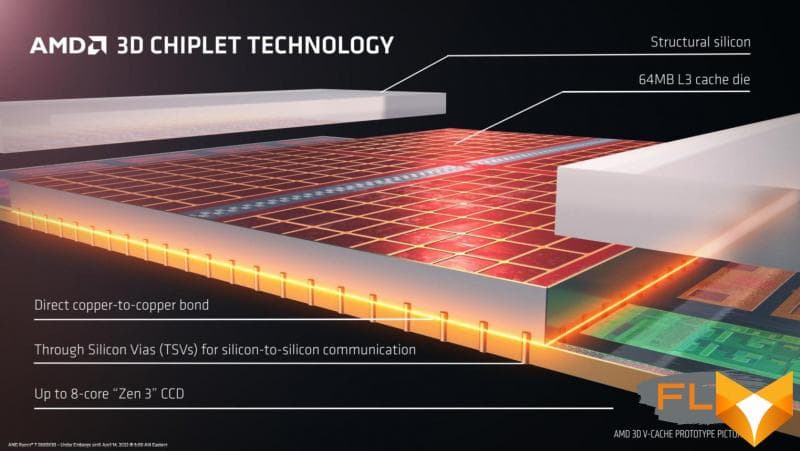
In order to place the 3D cache die add-on on the processor chip, AMD had to work with TSMC on a special manufacturing technique that would reduce the thickness of the two-piece CCD (Core Complex Die) and 3D cache combined device. As a result, it is reduced to the height of a single chip of conventional processors, thanks to which the Ryzen 7 5800X3D fits in exactly the same package as other processors in the Ryzen family, and does not require the use of any special cooling systems or their mounts.
This is achieved using two methods. Firstly, the semiconductor crystals used in the Ryzen 7 5800X3D are thinner in themselves. For example, the CCD chip for such processors has 95% silicon cut off beforehand, as a result of which its thickness is reduced from the original 0.4 to 0.02 mm. Secondly, to connect stacked chips, TSMC uses pads aligned flush with their surfaces instead of traditional microballoons in this case (SoIC technology). At the same time, CCD and 3D cache crystals with removed contacts are polished by chemical-mechanical methods and are joined tightly so that they are held on top of each other by van der Waals forces. It is also important that the parts of the CCD crystal that remain not covered by the 3D cache are built up with special silicon ingots to obtain a smooth assembly surface without a height difference.
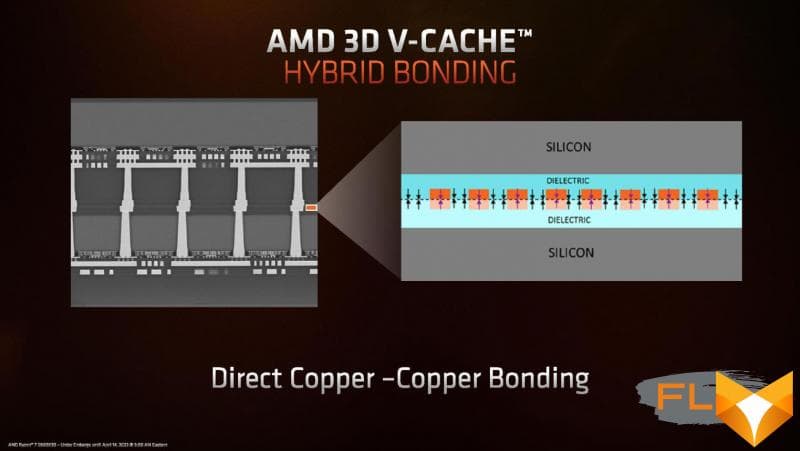
The technology of vertical connection of crystals used in the Ryzen 7 5800X3D is also distinguished by the fact that it provides a throughput of up to 2 TB / s, which is quite enough for the L3 cache to work. This speed was obtained due to the extremely high density of contacts in the connection, which are located with a step of 9 microns. For comparison, the current generation of Intel EMIB 2.5D mounting technology, which is used in Sapphire Rapids server processors, uses a pin pitch of 55 microns. As a result, as AMD points out, its technology along the way gives a serious gain in energy efficiency, as it allows you to use more signal lines with lower frequencies.

The die with the additional 64 MB cache has an area of 41 mm2, which is about half the 81 mm2 area of an eight-core CCD die. The number of transistors in such a cache is 4.7 billion. This is more than the number of transistors in the entire CCD (4.15 billion), which contains 32 MB of L3. But there is nothing to be surprised here: a higher density of transistors in a cache crystal is explained by the simplicity of the physical implementation of SRAM-memory in silicon. At the same time, 3D cache is produced in the same place as the base Ryzen crystals, at TSMC’s facilities using the N7 process technology.
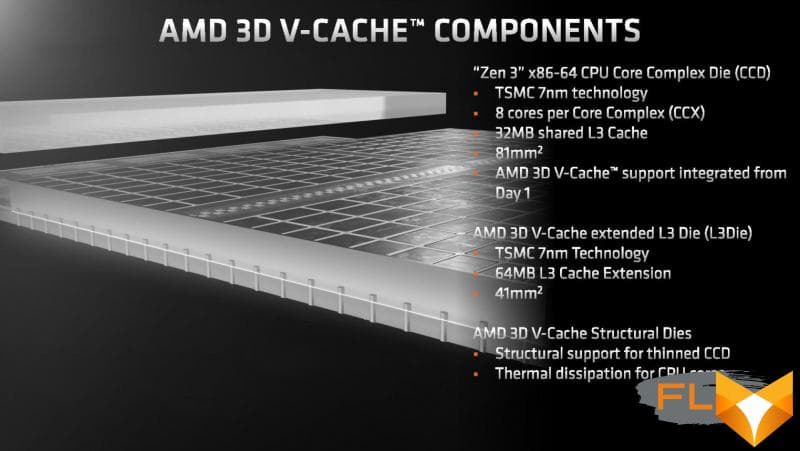
It’s important to understand that the extra cache that AMD added to the Ryzen 7 5800X3D as a second tier is not a separate entity. At the logical level, it seamlessly attaches to the existing L3 cache and works with it at the same frequency. Even the associativity of the resulting 96 MB L3 cache remains the same as that of the Ryzen 7 5800X – in both cases, the cache is 16-channel.
However, the increased L3 cache has not only advantages, but also certain disadvantages. Access to data in it takes more time, so the latency of such a cache is higher. This can be seen in synthetic benchmarks. While the L3 cache latency of the Ryzen 7 5800X is 40-45 cycles, the Ryzen 7 5800X3D L3 cache fetch takes 45-52 cycles.
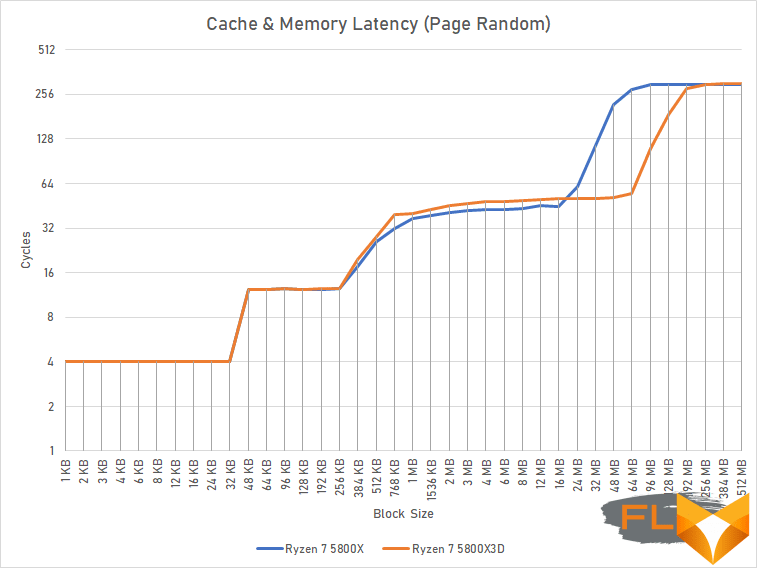
However, for applications that work with large amounts of data, a threefold increase in cache size in most cases should more than compensate for a small increase in latency.
At the same time, AMD is not yet going to implement 3D V-Cache technology everywhere. The Ryzen 7 5800X3D is the only desktop product that saw the light of day with vertical L3 cache technology. Although the company originally planned to equip the 12-core Ryzen 7 5900X processors with increased cache, these plans subsequently had to be abandoned. The 3D editing technology is very complex and does not scale well yet, so AMD decided to test it on a processor with a single CCD chip. It is possible that in the next generation of Ryzen, which will switch to the Zen 4 microarchitecture, this technology will be used more actively. However, you need to understand that, first of all, 3D V-Cache is a solution for the server segment, where processors with a super-capacious cache are much more in demand. Therefore, even if 3D V-Cache technology does not take root in consumer products, Epyc processors with additional cache memory chips will certainly be produced as before.
⇡#Ryzen 7 5800X3D vs Ryzen 7 5800X: what’s the difference
The Ryzen 7 5800X3D is an octa-core processor based on the Zen 3 microarchitecture, and in this it is no different from the Ryzen 7 5800X, which has been on the market for a year and a half. However, the Ryzen 7 5800X3D has tripled L3 cache, which ultimately makes significant adjustments to other specs as well. First of all, we are talking about clock frequencies. Due to the fact that in the Ryzen 7 5800X3D, a semiconductor die with cores carries another silicon die, it becomes more difficult to cool it. As a result, AMD was forced to reduce the operating frequencies of the Ryzen 7 5800X3D compared to the Ryzen 7 5800X by 200-400 MHz.
| Ryzen 7 5800X | Ryzen 7 5800X3D | |
|---|---|---|
| Platform | Socket AM4 | Socket AM4 |
| Microarchitecture | Zen 3 | Zen 3 |
| Technological process, mm | 7/12 | 7/12 |
| Cores/Threads | 8/16 | 8/16 |
| Frequency (nominal/turbo), GHz | 3.8-4.7 | 3.4-4.5 |
| L3 cache, MB | 32 | 96 |
| TDP, W | 105 | 105 |
| Memory | DDR4-3200 | DDR4-3200 |
| PCIe lanes | 24 × Gen4 | 24 × Gen4 |
| Integrated graphics | No | No |
| Official price | $449 | $449 |
In fact, the declared frequencies of the flagship octa-core processor with 3D cache are similar to the frequencies not of the Ryzen 7 5800X, but of the recently released Ryzen 7 5700X. But there is a caveat: the Ryzen 7 5700X has a TDP of 65W, while the Ryzen 7 5800X3D is a processor with a TDP of 105W, which is allowed to consume up to 142W.
To get a complete picture of the frequency formula of the Ryzen 7 5800X3D in practice, we plotted its frequency versus the number of active threads. The Cinebench R23 rendering test was used as a load.
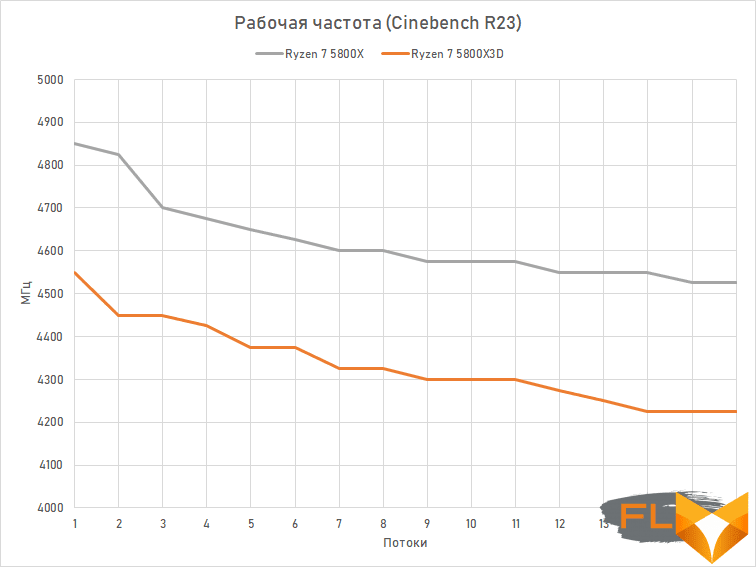
As follows from the graph, the difference in the actual operating frequencies of the Ryzen 7 5800X3D and Ryzen 7 5800X is almost the same over the entire load range and is 275-300 MHz. A lot or a little – tests will show, but it must be added that the Ryzen 7 5800X, unlike a processor with additional cache, can still be accelerated by a variety of methods: by enabling Precision Boost Overdrive 2, using Curve Optimizer, or something else, down to a simple assigning an increased fixed clock frequency. But for the Ryzen 7 5800X3D, all these approaches do not work. Since heat dissipation from the processor chip located on the bottom floor of the assembly is difficult, AMD not only severely limited the possible voltages for this CPU to 1.35 V from above, but also disabled all the usual overclocking functions, in particular, changing the multiplier, voltage, and PPT consumption limits , TDC, EDC. In other words, it is almost impossible to increase the frequency of the Ryzen 7 5800X3D – the only remaining method with changing the BCLK frequency does not give noticeable results.
Like all previous representatives of the Ryzen family, the new Ryzen 7 5800X3D is fully compatible with the Socket AM4 ecosystem – it can be used in any motherboards with 400 and 500 series chipsets. Moreover, AMD, together with motherboard manufacturers, is actively working on implementing support for Ryzen 7 5800X3D in older boards based on 300 series chipsets. Boards that receive a firmware update based on the AGESA 1.2.0.7 code will also be able to work with this CPU. This means that the Ryzen 7 5800X3D is well suited for upgrading older Socket AM4 systems. Moreover, this processor is the final point in the development of this ecosystem, and AMD is no longer going to release any other models for it.
Another factor that sharply distinguishes the Ryzen 7 5800X3D from a fellow without 3D V-Cache is the price. The Ryzen 7 5800X3D has a suggested price of $449, which is the same as the Ryzen 7 5800X official price. But in reality, an ordinary eight-core is now sold much cheaper – in American and European stores it can be found for a little over three hundred dollars. Moreover, the 12-core Ryzen 9 5900X is available for sale for $400, so the Ryzen 7 5800X3D seems to be quite an expensive processor compared to its brothers.
⇡#Power consumption and temperatures
Heat dissipation seems to have been AMD’s biggest pain point in getting the Ryzen 7 5800X3D ready for release. But the point is not in the additional heat dissipation of the 3D cache crystal (on the contrary, it practically does not contribute to CPU heating), but in the fact that the two-level layout makes it difficult to remove heat from the lower “floor”, where the hot CCD crystal with computing cores. It is for this reason that the Ryzen 7 5800X3D has limited clock speeds, but this is far from the only measure that AMD had to take.
So, in Ryzen 7 5800X3D, the company used a new B2 stepping chip instead of B0, which we are used to seeing in regular Ryzen 7 5800X. The upgraded silicon has no difference in features or performance, but has lower leakage currents, allowing it to be used at lower voltages. While the operating voltage range of our Ryzen 7 5800X instance ranged from 1.0 to 1.462 V depending on the load, the Ryzen 7 5800X3D on the B2 stepping was content with voltages in the range from 0.95 to 1.281 V. And therefore, the Ryzen 7 5800X3D should be noticeably more economical.
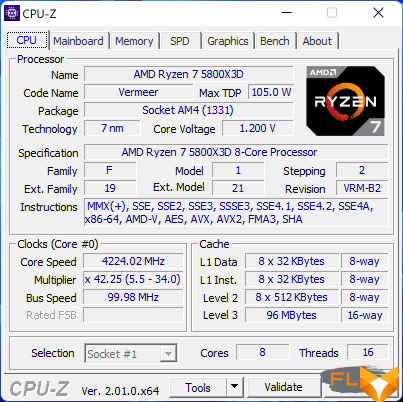
This is perfectly confirmed by practical measurements. So, in multi-threaded rendering in Blender, the consumption of the Ryzen 7 5800X3D is just over 100 watts, while the Ryzen 7 5800X consumes almost one and a half times more under the same conditions – 145 watts.
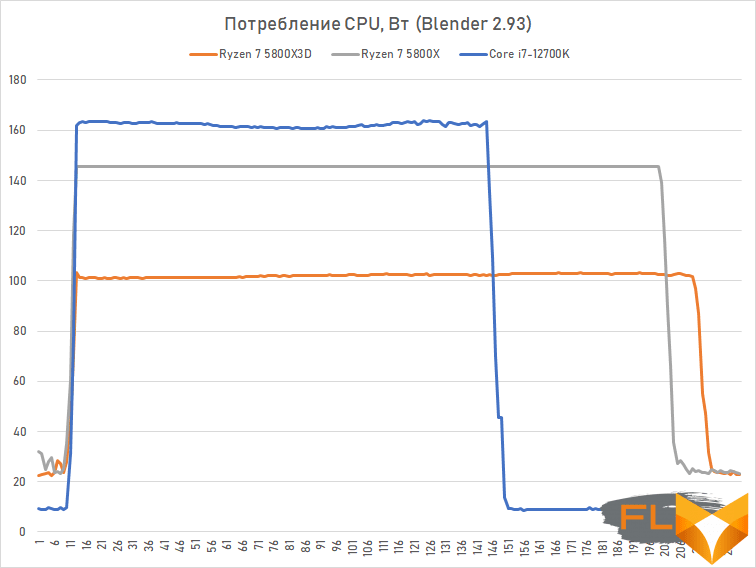
If you look at the game load (in Full HD with maximum quality settings), then the Ryzen 7 5800X3D turns out to be more economical than not only a fellow without a 3D cache, but also an Alder Lake generation Core i7-12700K processor. In other words, the new stepping of the CCD die plus lower voltages and frequencies allowed AMD to design an unexpectedly energy-efficient processor, although such a task was not even set initially.



The temperature regime of the Ryzen 7 5800X3D also looks good, although one could expect more from a processor with a power consumption of no more than 105 W. However, due to the difficulties in removing heat from the “shelf” of crystals, even under light loads, the processor heats up to temperatures of about 60-70 degrees. However, for an AMD product, this is not so much: when rendered in Blender, the new Ryzen 7 5800X3D turns out to be about 10-12 degrees colder than the old Ryzen 7 5800X. And even the Core i7-12700K, which is much easier to remove heat from the die, shows slightly higher temperatures during multi-threaded rendering. (In the experiments in question, the same custom FSS system on EKWB components was used to cool all three processors.)

At the same time, in games where the load is less stable and more lightweight, the Ryzen 7 5800X3D noticeably loses to the Intel processor in terms of temperature. Where the Core i7-12700K only reaches 50-55 degrees, the Ryzen 7 5800X3D reaches 60-65 degrees. However, the classic Ryzen 7 5800X is much hotter under the same conditions – in gaming systems based on it, you will have to face more than 70-degree heating even when using a very efficient cooling system.
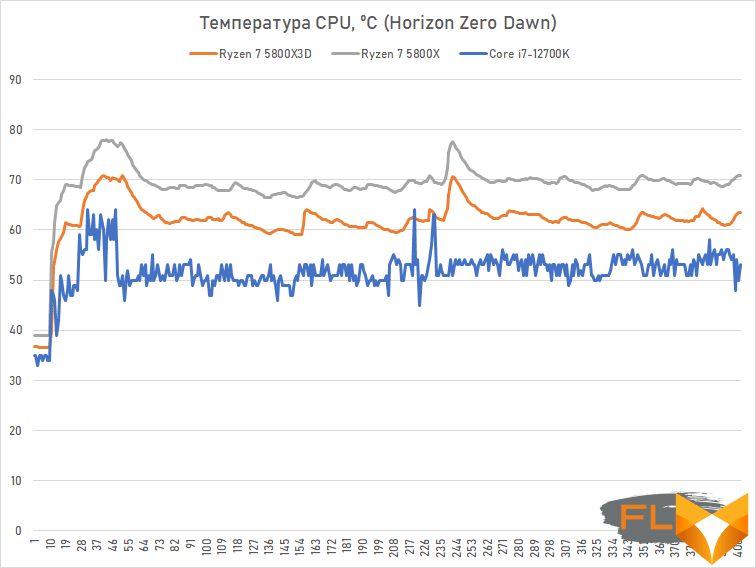
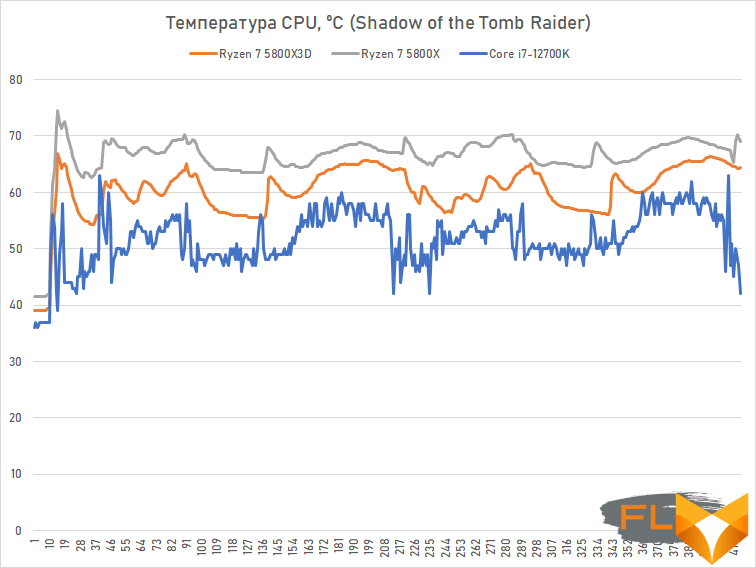
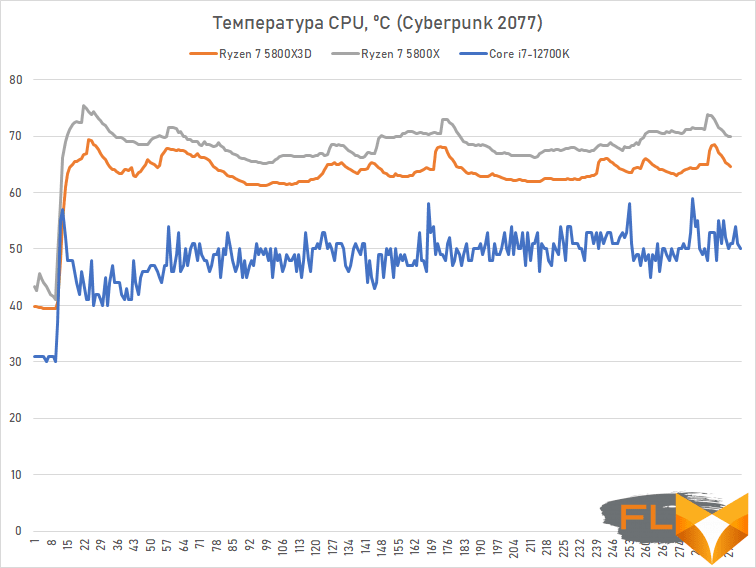
The Ryzen 7 5800X3D is the final processor for the Socket AM4 ecosystem as AMD plans to migrate to another socket in the future. Therefore, many will certainly consider it as an option for upgrading older systems. And the good news is that in this case, you can practically not think about such things as the quality of the power system on the motherboard and the performance of the cooling system. The Ryzen 7 5800X3D is the most economical Ryzen processor of all models with a TDP of 105W, which is quite comparable in thermal and power characteristics to 65W models when Precision Boost Overdrive 2 is enabled for them.
⇡#Description of the test system and testing methodology
AMD is talking about the Ryzen 7 5800X3D as the best processor for gaming. At the same time, Intel is of the opinion that the best processor for gaming is the Core i9-12900K. That is why the testing plot will be built around the confrontation between these two CPUs in one way or another. However, it would be incomplete if two other important processors did not take part in it – the eight-core Ryzen 7 5800X without 3D cache and the 12-core Ryzen 9 5900X, which is now cheaper than the Ryzen 7 5800X3D. In addition, to complete the picture, several other flagship models from AMD and Intel were added to the number of tested CPUs.
- Processors:
- AMD Ryzen 9 5950X (Vermeer, 16 cores + SMT, 3.4-4.9GHz, 64MB L3);
- AMD Ryzen 9 5900X (Vermeer, 12 cores + SMT, 3.7-4.8GHz, 64MB L3);
- AMD Ryzen 7 5800X3D (Vermeer, 8 cores + SMT, 3.4-4.5GHz, 96MB L3);
- AMD Ryzen 7 5800X (Vermeer, 8 cores + SMT, 3.8-4.7GHz, 32MB L3);
- Intel Core i9-12900K (Alder Lake, 8P+8E-cores + HT, 3.5-5.3/2.4-3.9GHz, 30MB L3);
- Intel Core i7-12700K (Alder Lake, 8P+4E-cores + HT, 3.6-5.0/2.7-3.8GHz, 25MB L3).
- CPU cooler: EKWB custom coolant
- Motherboards:
- ASUS ROG Strix X570-E Gaming WiFi (Socket AM4, AMD X570);
- ASUS ROG Strix Z690-F Gaming WiFi (LGA1700, Intel Z690).
- Memory:
- 2x16GB DDR4-3600 SDRAM, 16-18-18-38 (Crucial Ballistix RGB BL2K16G36C16U4BL);
- 2x16GB DDR5-6000 SDRAM, 40-40-40-76 (G.Skill Trident Z5 RGB F5-6000U4040E16GX2-TZ5RK).
- Video Card: NVIDIA GeForce RTX 3090 Founders Edition (GA102, 1395-1695/19500MHz, 24GB GDDR6X 384-bit).
- Disk subsystem: Intel SSD 760p 2TB (SSDPEKKW020T8X1).
- Power supply: Thermaltake Toughpower DPS G RGB 1000W Titanium (80 Plus Titanium, 1000W).
All compared processors were tested with canceled artificial consumption restrictions. This means that the PPT limits (for the AMD platform) and PL1/PL2 (for the Intel platform) are ignored, instead the maximum possible frequencies are used in order to obtain maximum performance.
The memory subsystems were configured using XMP profiles. Socket AM4 processors were tested with DDR4-3600, and Alder Lake with DDR5-6000.
Testing was performed on the Microsoft Windows 11 Pro (21H2) Build 22000.282.0 operating system with KB5005635 and KB5006746 updates installed and using the following driver set:
- AMD Chipset Driver 4.03.03.431;
- Intel Chipset Driver 10.1.18838.8284;
- Intel SerialIO Driver 30.100.2105.7;
- Intel Management Engine Interface 2124.100.0.1096;
- NVIDIA GeForce 512.16 Driver.
Description of the tools used to measure computing performance:
Comprehensive benchmarks:
- Futuremark PCMark 10 Professional Edition 2.1.2508 – testing in Essentials scenarios (typical work of the average user: launching applications, surfing the Internet, video conferencing), Productivity (office work with a word processor and spreadsheets), Digital Content Creation (creating a digital content: photo editing, non-linear video editing, rendering and visualization of 3D models).
- 3DMark Professional Edition 2.22.7336 – testing in the CPU Profile 1.1 scenario with eight active threads and at the maximum possible processor load.
Applications:
- 7-zip 21.02 – archiving speed testing. The time taken by the archiver to compress a directory with various files with a total volume of 3.1 GB is measured. Uses LZMA2 algorithm and maximum compression ratio.
- Adobe Photoshop 2021 22.4.3 – Graphics performance testing. The average execution time of the Puget Systems Adobe Photoshop CC Benchmark 18.10 test script, which simulates the typical processing of an image taken by a digital camera, is measured.
- Adobe Photoshop Lightroom Classic 10.3 – Performance test for batch processing of a series of RAW images. The test scenario includes post-processing and export to JPEG at a resolution of 1920 × 1080 and a maximum quality of two hundred 16-megapixel RAW images taken with a Fujifilm X-T1 digital camera.
- Adobe Premiere Pro 2021 15.4.0 – performance testing for non-linear video editing. This measures the rendering time to YouTube 4K for a project containing HDV 2160p30 footage with various effects applied.
- Blender 2.93.5 – testing the speed of the final rendering in one of the popular free packages for creating three-dimensional graphics. The duration of building the final model pavillon_barcelona_v1.2 from Blender Benchmark is measured.
- Mathworks Matlab R2021b (9.11.0) – testing the speed of engineering and mathematical calculations in a popular mathematical package. A standard benchmark is used, which includes matrix and vector operations, the solution of differential and symmetric sparse linear systems of equations, as well as the construction of 2D and 3D plots.
- Microsoft Visual Studio 2017 (15.9.40) — measuring the compilation time of a large MSVC project, a professional package for creating three-dimensional graphics Blender version 2.79b.
- Stockfish 14.1 – testing the speed of the popular chess engine. The speed of enumeration of options in the position “1q6/1r2k1p1/4pp1p/1P1b1P2/3Q4/7P/4B1P1/2R3K1 w” is measured.
- SVT-AV1 v0.8.6 – testing the speed of video transcoding to the promising AV1 format. Performance is measured using a raw 1080p@50FPS AVC video file with a bitrate of about 30 Mbps.
- Topaz Video Enhance AI v2.3.0 – performance testing in an AI-based program to improve video detail. The test uses the original video at 640×360 resolution, which is doubled using the Artemis Anti Aliasing v9 model.
- V-Ray 5.00 – Benchmark the performance of a popular rendering system using the standard V-Ray Benchmark Next application.
- x265 3.5+8 10bpp – testing the speed of video transcoding to H.265/HEVC format. To evaluate performance, we use the original 2160p@24FPS AVC video file with a bitrate of about 42 Mbps.
Games:
- Chernobylite. Resolution 1920 × 1080: Graphics Quality = Ultra. Resolution 3840 × 2160: Graphics Quality = Ultra.
- Civilization VI: Gathering Storm. Resolution 1920×1080: DirectX 12, MSAA=4x, Performance Impact=Ultra, Memory Impact=Ultra. Resolution 3840 × 2160: DirectX 12, MSAA = 4x, Performance Impact = Ultra, Memory Impact = Ultra.
- Cyberpunk 2077. 1920×1080 resolution: Quick Preset = Ray Tracing – Ultra. Resolution 3840 × 2160: Quick Preset = Ray Tracing – Ultra.
- Far Cry 6. Resolution 1920 × 1080: Graphics Quality = Ultra, HD Textures = On, Anti-Aliasing = TAA. Resolution 3840 × 2160: Graphics Quality = Ultra, Anti-Aliasing = TAA.
- Hitman 3. 1920 × 1080 resolution: Super Sampling = 1.0, Level of Detail = Ultra, Texture Quality = High, Texture Filter = Anisotropic 16x, SSAO = Ultra, Shadow Quality = Ultra, Mirrors Reflection Quality = High, SSR Quality = High, Variable Rate Shading = Quality. Resolution 3840 × 2160: Super Sampling = 1.0, Level of Detail = Ultra, Texture Quality = High, Texture Filter = Anisotropic 16x, SSAO = Ultra, Shadow Quality = Ultra, Mirrors Reflection Quality = High, SSR Quality = High, Variable Rate Shading =Quality.
- Horizon Zero Dawn. Resolution 1920 × 1080: Preset = Ultimate Quality. Resolution 3840 × 2160: Preset = Ultimate Quality.
- Marvel’s Guardians of the Galaxy. Resolution 1920×1080: Graphics Preset = Ultra. Resolution 3840 × 2160: Graphics Preset = Ultra.
- Serious Sam: Siberian Mayhem. Resolution 1920 × 1080: Direct3D 11, CPU Speed = Ultra, GPU Speed = Ultra, GPU Memory = Ultra. Resolution 3840 × 2160: Direct3D 11, CPU Speed = Ultra, GPU Speed = Ultra, GPU Memory = Ultra.
- Shadow of the Tomb Raider. Resolution 1920×1080: DirectX12, Preset=Highest, Anti-Aliasing=TAA. Resolution 3840 × 2160: DirectX12, Preset = Highest, Anti-Aliasing = Off.
- The Riftbreaker. Resolution 1920 × 1080: DirectX12, Texture Quality = High, Raytraced soft shadows = On, Ray traced shadow quality = Ultra, Raytraced ambient occlusion = On. Resolution 3840 × 2160: DirectX12, Texture Quality = High, Raytraced soft shadows = On, Ray traced shadow quality = Ultra, Raytraced ambient occlusion = On.
- Total War: Warhammer III. Resolution 1920 × 1080: Quality = Ultra. Resolution 3840 × 2160: Quality = Ultra.
- Watch Dogs Legion. Resolution 1920×1080: DirectX 12, Quality=Ultra, RTX=Off, DLSS=Off. Resolution 3840 × 2160: DirectX 12, DirectX 12, Quality = Ultra, RTX = Off, DLSS = Off.
In all gaming tests, the results are the average number of frames per second, as well as the 0.01-quantile (first percentile) for FPS values. The use of the 0.01-quantile instead of the minimum FPS is due to the desire to clean up the results from random bursts of performance that were provoked by reasons not directly related to the operation of the main components of the platform.
⇡#Performance in complex benchmarks
The results in the PCMark 10 test, which measures performance in typical common work scenarios, do not inspire much optimism. In any of the three types of load – office, Internet activity and when working with content – the Ryzen 7 5800X3D performs slower than its “normal” counterpart, the Ryzen 7 5800X. That is, the test clearly indicates that increasing the amount of cache memory cannot be a universal recipe for increasing performance. For average applications, 32 MB of L3 cache is enough, and its further increase to the detriment of the clock frequency does not lead to anything good. For this reason, the Ryzen 7 5800X3D is in last place on the charts in any scenarios from PCMark 10 – it is not necessary to say that the new processor is able to compete with the Ryzen 9 5900X or Core i7-12700K.

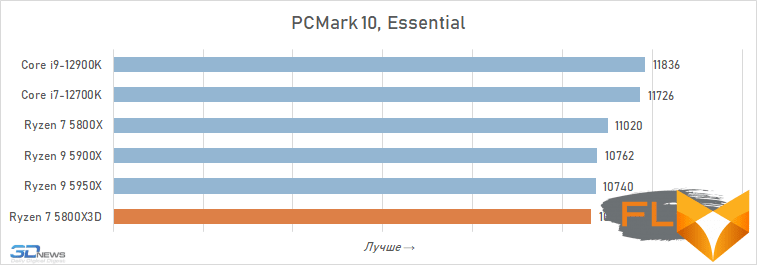
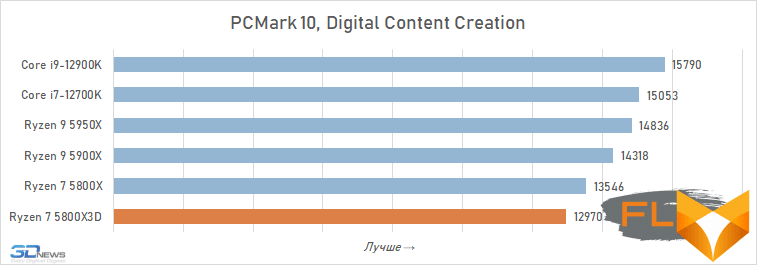
Approximately the same picture is observed in the 3DMark CPU Profile test, which measures the refined performance of processors when simulating the game environment (the physical environment and the actions of abstract NPCs). Since in this case we are not talking about working with large data arrays, the results of the Ryzen 7 5800X3D look very modest. It is 7% behind the classic eight-core Ryzen 7 5800X and loses miserably to the Core i7-12700K, which is more than a third ahead of AMD’s new product.
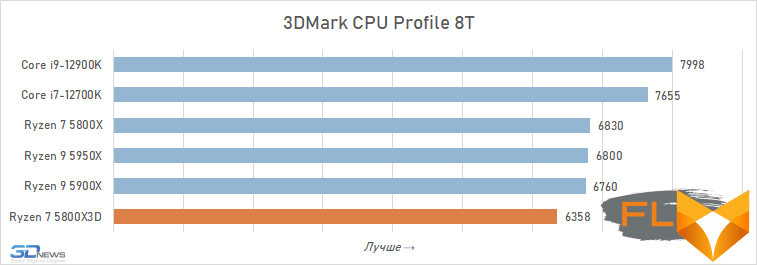
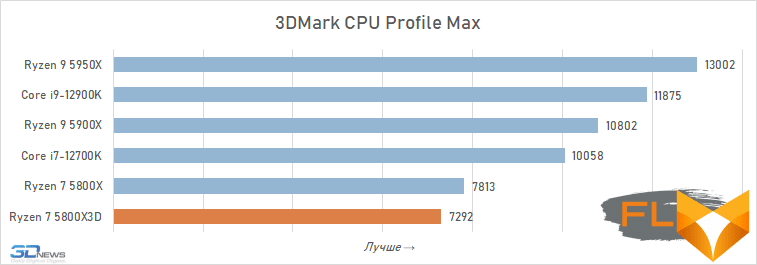
However, the result in 3DMark CPU Profile should not be taken as a harbinger of the failure of the Ryzen 7 5800X3D in games. This test affects only one aspect of gaming performance and bypasses the work that falls on the processor when exchanging texture and graphic information with a video card, where a huge L3 cache can play a positive role.
⇡#Application Performance
Performance in resource-intensive tasks related to creating and processing content depends much more on the number of processing cores and clock speed of the processor than on the size of its cache, at least when it comes to Zen 3 microarchitecture media. As a result, in most cases, Ryzen 7 The 5800X3D shows no noticeable performance difference from a regular octa-core processor with a 32MB L3 cache.
However, among the applications there are those that actively work with streaming data and where the positive effect of the 96 MB L3 cache is still visible. For example, when archiving, image pipelining in Lightroom, compiling code in Visual Studio, and technical computing in Matlab, the 3D cache-enhanced Ryzen 7 5800X3D outperforms the Ryzen 7 5800X, despite the lower clock speed. But even in such tasks, the advantage of the new processor cannot be called significant, and it does not give it a chance to overtake CPU models with a large number of processing cores.
In total, we tested the performance in a dozen different applications, and in none of them did the new AMD with increased cache memory be able to overtake the current representatives of the Ryzen 9, Core i7 and i9 series. And this means that Ryzen 7 5800X3D should not be considered as an option for workstations. To solve almost any resource-intensive computing tasks, any of the processors with a large number of cores is much better suited, in addition, the 12-core Ryzen 9 5900X and Core i7-12700K will cost the user less. Moreover, if we talk about the weighted average performance in heterogeneous “heavy” applications, then the new AMD eight-core is worse than the time-tested Ryzen 7 5800X, by about 1.5%.
Rendering:
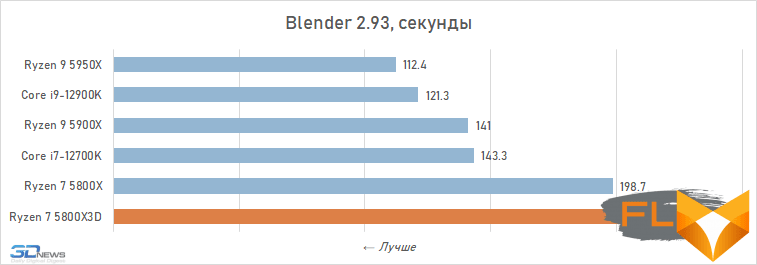
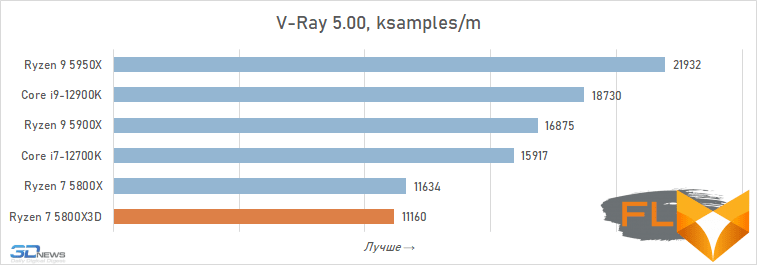
Photo processing:
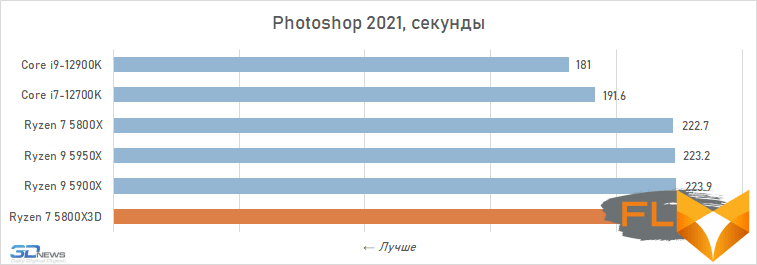
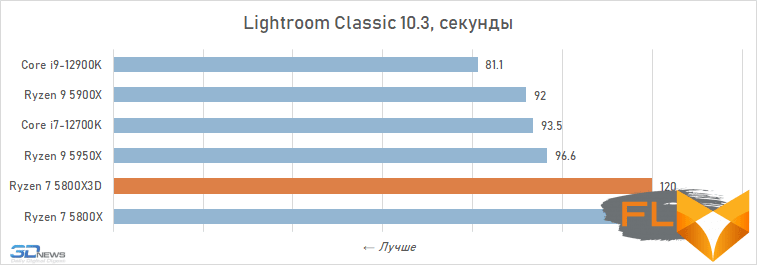
Video work:
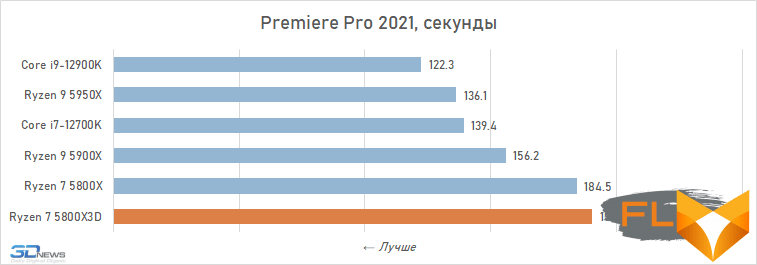
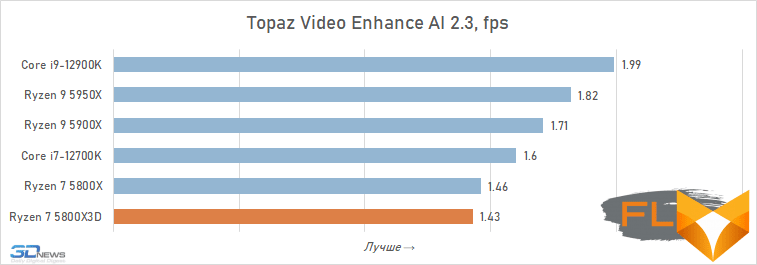
Video transcoding:
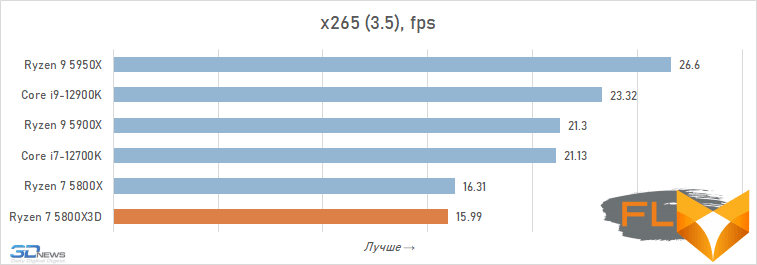
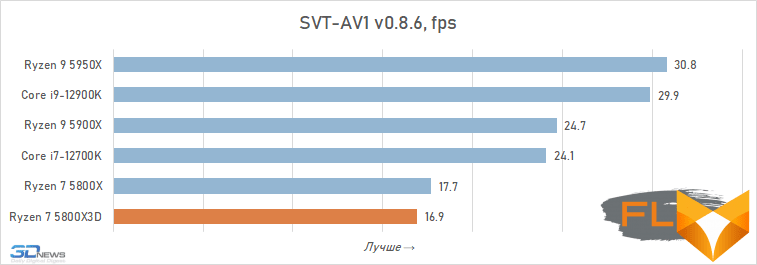
Compilation:
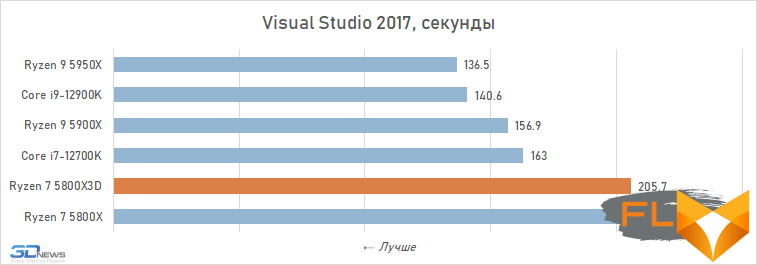
Archiving:
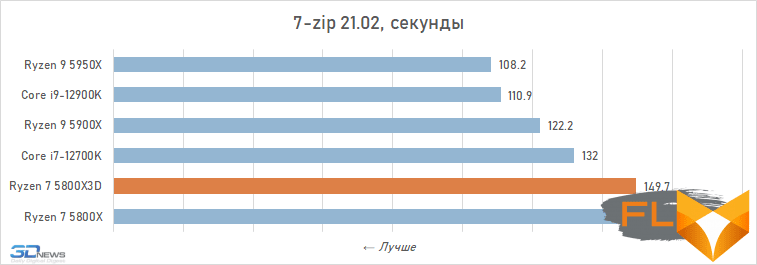
Chess:
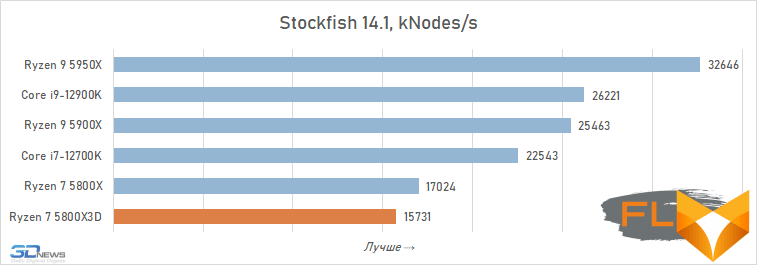
Mathematical calculations:
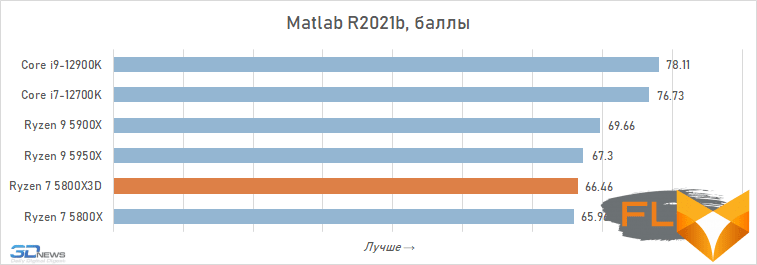
⇡#1080p gaming performance
This section is the central part of all testing. It is on the gaming performance of the Ryzen 7 5800X3D that AMD is focusing, claiming that a threefold increase in L3 cache can add an additional 15% to gaming performance. True, this value was obtained by the company based on the results of its own testing in six specially selected games, and therefore may not describe the situation as a whole.
And indeed, our independent testing in 12 games does not converge with AMD’s assessment. According to our data, the average advantage of the Ryzen 7 5800X3D over the Ryzen 7 5800X in the average frame rate in Full HD resolution is only 11%, but at the same time, in terms of minimum FPS, the new eight-core with 3D cache is much more productive than the old one – by 16%.
In any case, AMD is absolutely right that 3D V-Cache technology is of interest mainly to gamers. With the Ryzen 7 5800X3D being the Socket AM4 processor with the largest cache memory, it easily becomes AMD’s best solution for gaming builds today. Not only the Ryzen 7 5800X, but also the multi-core Ryzen 9 5900X and Ryzen 9 5950X cannot compete with it: the new product bypasses all of them by about the same amount.
However, AMD’s claim that the Ryzen 7 5800X3D is the fastest gaming CPU is not confirmed in gaming tests. If we talk about the average FPS, then it falls short of the performance of the Core i9-12900K by about 1.5%, and this can still be called a slight lag. In terms of the minimum frame rate, the gap is more serious – in this case, the Intel flagship provides a 7% better result. In addition, the Ryzen 7 5800X3D doesn’t even outperform Intel’s lower-end Core i7-12700K processor. That is, from the point of view of the minimum frame rate, not only the flagship 16-core Alder Lake, but also the model with 12 cores looks preferable to the new AMD with 3D cache.
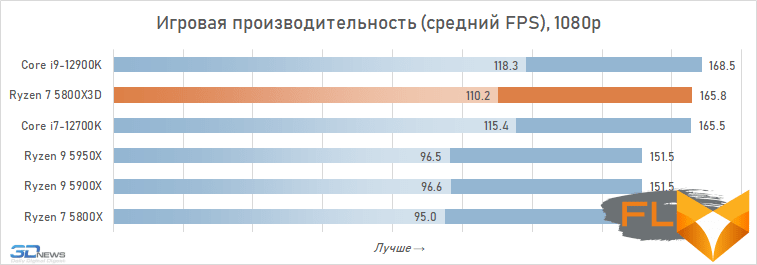
However, the situation in different games may vary. We found at least three games where the Ryzen 7 5800X3D actually happens to be the fastest CPU. These are Marvel’s Guardians of the Galaxy, Serious Sam: Siberian Mayhem and Shadow of the Tomb Raider. But even in them, the Ryzen 7 5800X3D can’t boast of superiority in terms of the minimum frame rate. Therefore, until AMD offers processors on the new Zen 4 microarchitecture, the representatives of the Alder Lake family will continue to be the best option for gaming systems.
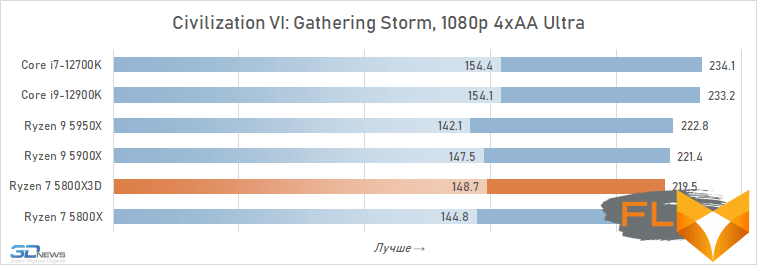
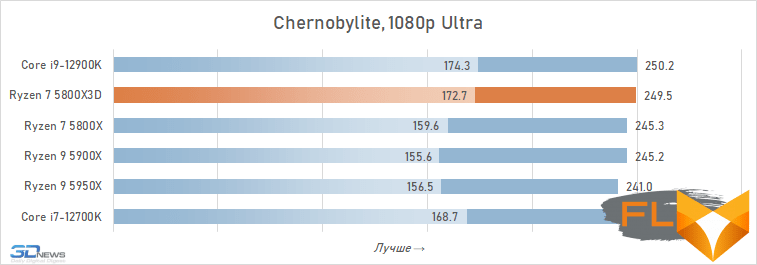
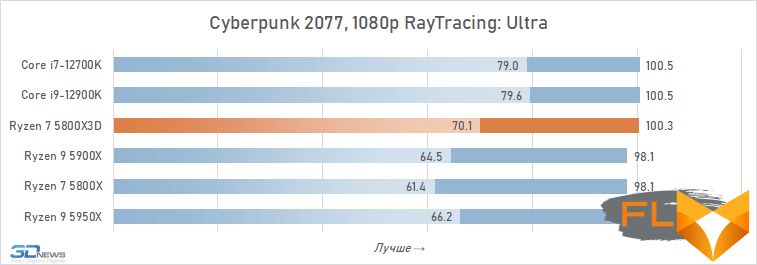
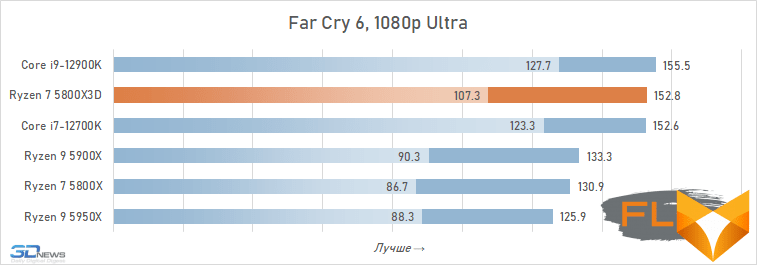
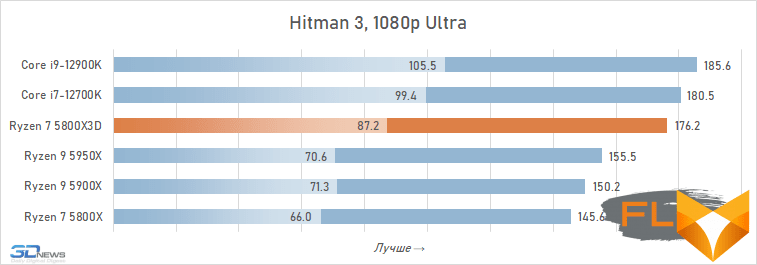

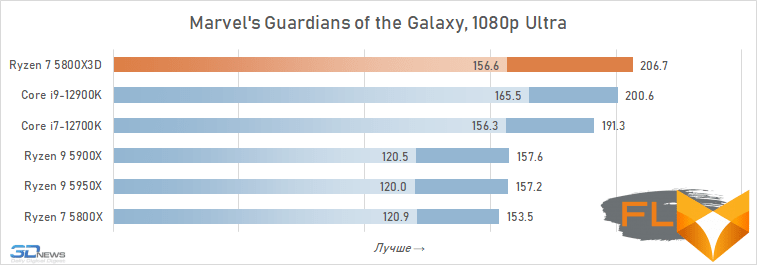

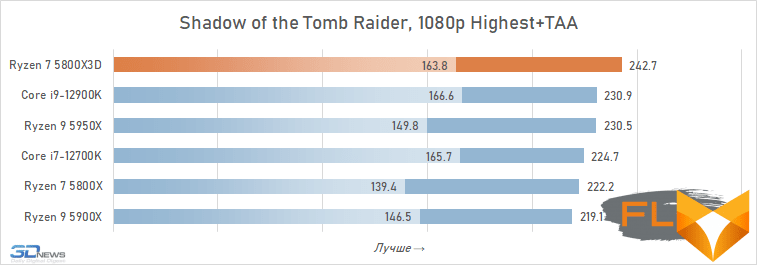
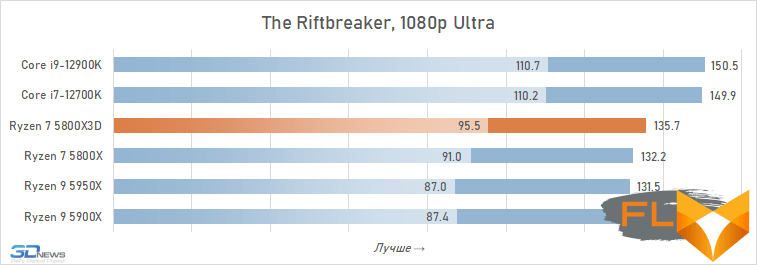

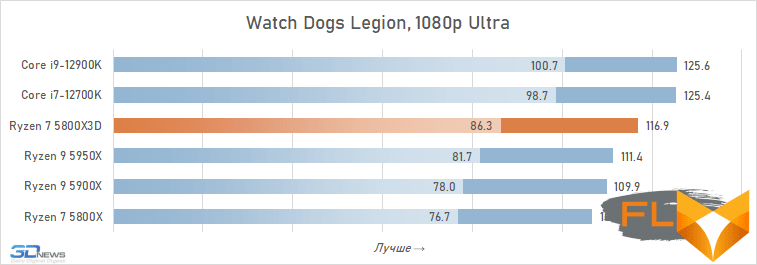
⇡#Gaming performance at 2160p
The graphics of modern games are becoming more and more complex, and in 4K resolution, the evolution is gradually moving towards redistributing the load in favor of the video card. Therefore, the farther, the less impact on the frame rate at this resolution has the CPU, even if the system has one of the fastest gaming graphics cards installed. The increase in L3 cache, which AMD has resorted to, does not change anything here – all processors from the upper price category offer a similar frame rate. Even if you follow not the average, but the minimum FPS, the gap between different solutions is noticeable only in fairly rare games. But where it catches the eye, the Ryzen 7 5800X3D is again inferior to the Core i9-12900K, which does not give the new AMD the right to be called the fastest processor for games, even if we keep in mind 4K resolution.

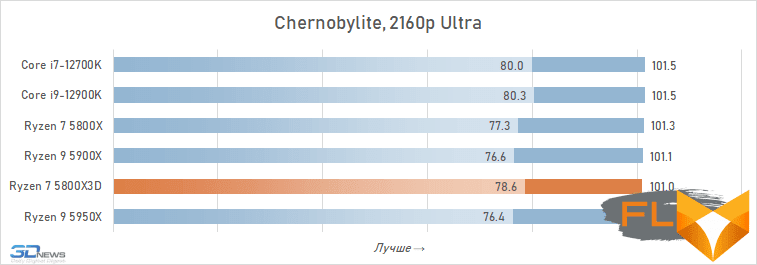
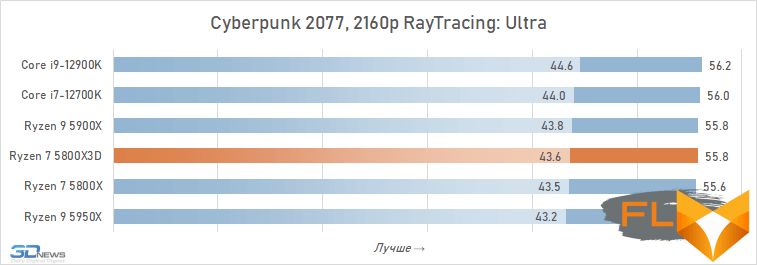
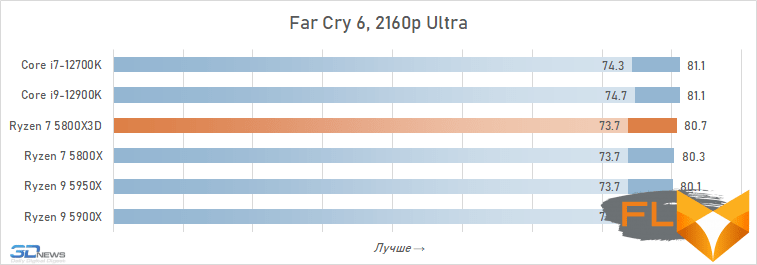
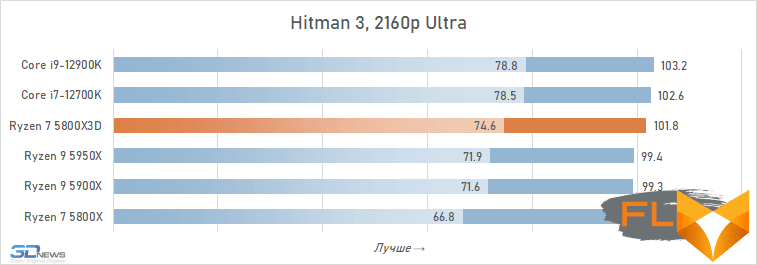
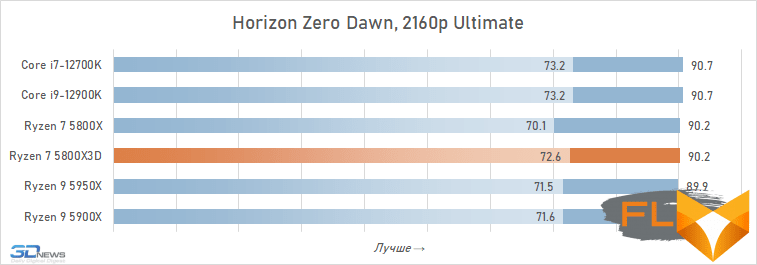
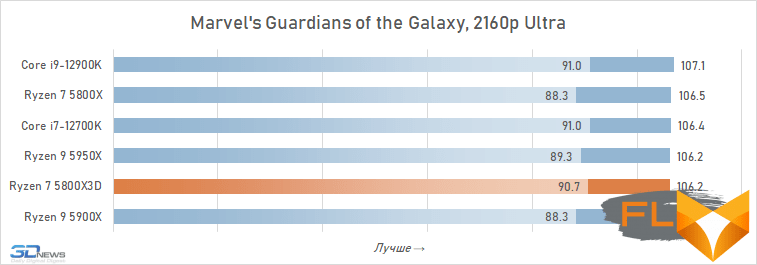
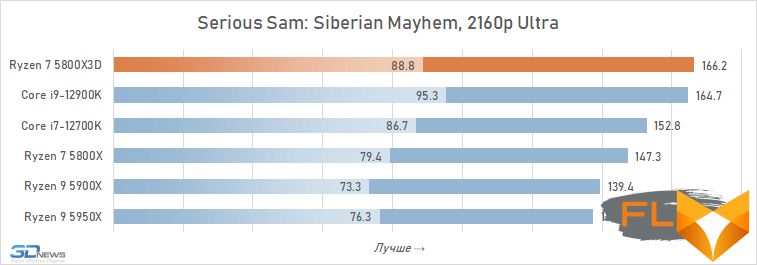

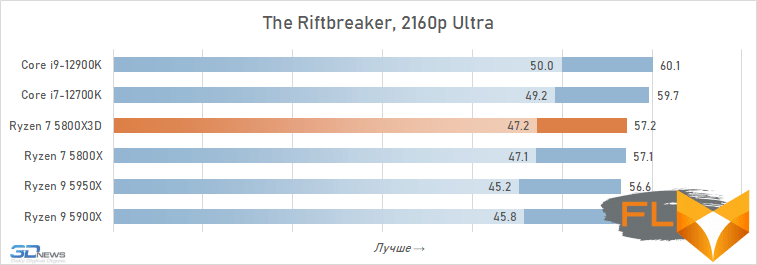
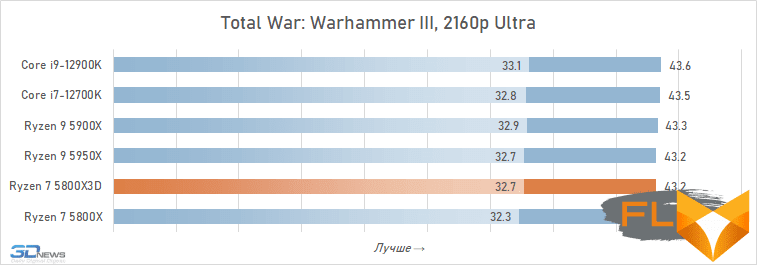
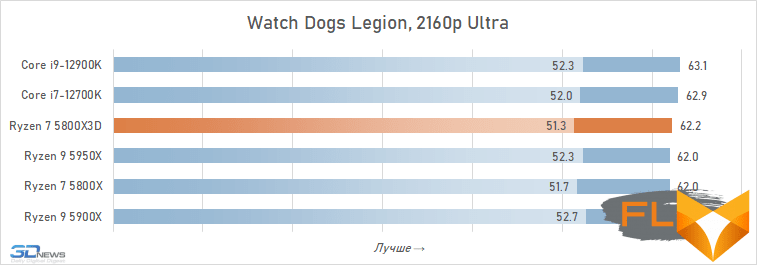
⇡#Conclusions
In terms of technology, the Ryzen 7 5800X3D is a very interesting product, the acquaintance with the device is truly admirable. AMD has come up with and implemented a great plan to breathe new life into the 2020 processor. Moreover, it is implemented using the most advanced approaches to the layout of crystals – by scaling the proprietary chiplet design in the third dimension. And even if the additional chiplet with which AMD improved the old Ryzen 7 5800X is just a SRAM memory chip that increases the L3 cache, this does not change the essence. We’ve never seen anything like it before, and the Ryzen 7 5800X3D is the first mainstream consumer processor to use 3D mounting technologies.
However, technological innovation alone is clearly not enough to make a comprehensively attractive product out of Ryzen 7 5800X3D, and its consumer qualities do not cause stormy delight at all. First, this eight-core processor is quite expensive – AMD is currently selling the Ryzen 7 5800X3D for $449, which is even more expensive than the Ryzen 9 5900X. Secondly, the new octa-core is not universal: the increased L3 cache is combined with lower clock speeds, which makes it ill-suited for many workloads. And thirdly, even in games where the Ryzen 7 5800X3D demonstrates a really serious advantage over its counterparts without a 3D cache, it is still not the most productive option compared to the representatives of the Alder Lake family. Moreover, not only the flagship Core i9-12900K can offer a higher level of FPS, but also the more affordable Core i7-12700K, which is cheaper than the Ryzen 7 5800X3D.
Thus, the Ryzen 7 5800X3D cannot be classified as a product that is attractive to all enthusiasts without exception. On the contrary, this is a rather niche processor, which hardly makes any sense for new gaming configurations, since there are options on the market that are faster, more versatile, and more profitable. In addition, the life cycle of the Socket AM4 platform is coming to an end, and it is hardly advisable to use it in new high-end PCs.
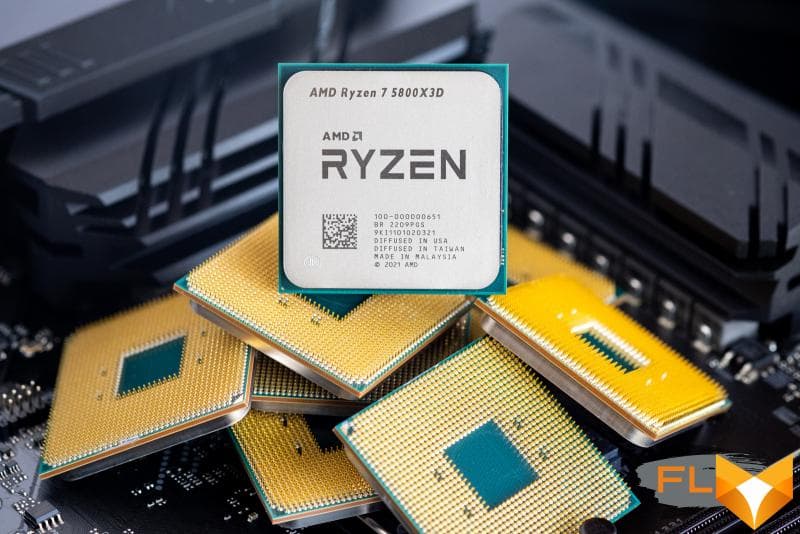
But for upgrading old gaming Socket AM4 assemblies, the Ryzen 7 5800X3D is the best fit, because it provides the highest FPS that is possible in this ecosystem, and nothing more interesting will obviously appear for it. But more importantly, the Ryzen 7 5800X3D is able to seamlessly fit into systems that currently use first-generation Ryzen processors. AMD is actively cooperating with motherboard manufacturers and is trying to make sure that Socket AM4 motherboards on any chipsets, including the very old X370 and B350, get Ryzen 7 5800X3D support. In addition, this processor itself is surprisingly economical and does not impose any special requirements on the power of power supply and cooling systems.
So, if you’re planning on upgrading your old PC with AMD components, moving to the Ryzen 7 5800X3D is a very tempting option. Such a replacement will make it easy to bring up the processor component of gaming performance in a system assembled three or even five years ago to a modern level. True, while such an upgrade will cost a lot.
FAQ Ryzen 7 5800x3d processor review
How does AMD’s Ryzen 7 5800X3D perform as a gaming processor compared to standard Ryzen 7 5800X?
AMD’s Ryzen 7 5800X3D, with its new 3D V-Cache technology, provides a significant performance gain in gaming over the standard Ryzen 7 5800X, especially in gaming benchmarks at 1080p resolution.
What kind of DDR4 memory compatibility does the Ryzen 7 5800X3D offer for gaming?
The Ryzen 7 5800X3D is compatible with DDR4 memory, which is sufficient for current gaming needs, offering stable performance and compatibility with most current-gen motherboards.
Does AMD claim the Ryzen 7000 series to be the fastest gaming processor?
AMD claims that the Ryzen 7000 series will offer significant performance gains, potentially making it one of the fastest gaming processors, especially when it comes to gaming at 1080p.
How does the Zen 3 architecture in the Ryzen 7 5800X3D enhance CPU performance?
The Zen 3 architecture in the Ryzen 7 5800X3D enhances CPU performance by improving efficiency and processing speed, which is crucial for both gaming and general desktop CPU tasks.
Will I need to buy a new motherboard for the Ryzen 7 5800X3D?
You might need to buy a new motherboard for the Ryzen 7 5800X3D if your current motherboard does not support the Zen 3 architecture or the specific socket and chipset requirements.
What is the amount of L3 cache in the Ryzen 7 5800X3D, and how does it affect gaming?
The Ryzen 7 5800X3D has a significant amount of L3 cache, specifically 64MB, thanks to AMD’s 3D V-Cache technology. This large cache size enhances gaming performance by allowing more data to be quickly accessed by the CPU cores.
How do the Ryzen 5000 series processors, like the Ryzen 7 5800X3D, compare to Intel’s offerings in gaming benchmarks?
In gaming benchmarks, Ryzen 5000 series processors, like the Ryzen 7 5800X3D, often lead over their Intel counterparts, especially in games that benefit from AMD’s enhanced cache and CPU performance.
Does the Ryzen 7 5800X3D use DDR5 memory, and how does this impact gaming?
The Ryzen 7 5800X3D primarily uses DDR4 memory. While DDR5 offers higher bandwidth, DDR4 still provides excellent performance for gaming with the Ryzen 7 5800X3D.
With AMD’s Ryzen 7 5800X3D, what new features has AMD introduced for gaming CPUs?
With AMD’s Ryzen 7 5800X3D, AMD has introduced new 3D V-Cache technology, significantly increasing the amount of L3 cache, which in turn boosts gaming performance by reducing latency in CPU-intensive tasks.
How does AMD’s 3D V-Cache technology in the Ryzen 7 5800X3D compare to the original Ryzen chips?
AMD’s 3D V-Cache technology in the Ryzen 7 5800X3D marks a significant advancement over the original Ryzen chips, offering a much larger L3 cache, which helps in achieving faster and more efficient data processing for CPU-intensive tasks like gaming.
